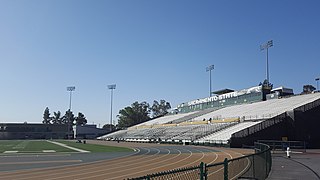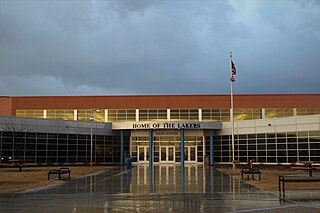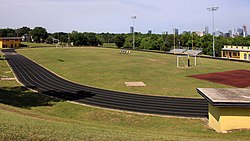
Darrell K Royal Memorial Stadium, located in Austin, Texas, on the campus of the University of Texas, has been home to the Longhorns football team since 1924. The stadium has delivered a home field advantage with the team's home record through November 24, 2023 being 399–122–10 (.761). The official stadium seating capacity is 100,119, making the stadium the fourth largest in the Southeastern Conference, the seventh largest stadium in the United States, and the ninth largest stadium in the world.

David Booth Kansas Memorial Stadium is a college football stadium in Lawrence, Kansas, on the campus of the University of Kansas. The stadium was opened in 1921, and is the seventh oldest college football stadium in the country, and is widely recognized as the oldest west of the Mississippi River. It is the home stadium of the Kansas Jayhawks football team.

Fouts Field was a stadium at the University of North Texas, located in Denton, Texas. Its primary use from its opening in 1952 until 2010 was as the home field for North Texas Mean Green football. Over its 59-year history, Fouts Field was the college home of players such as Joe Greene, Abner Haynes, Steve Ramsey, and Steve Anderson, who would later gain worldwide fame as pro wrestler Steve Austin.

Dix Stadium is a stadium in Kent, Ohio, United States. It is primarily used for American football, and is the home field of the Kent State Golden Flashes football team. In addition, since 2016 the stadium is also home to the Kent State women's soccer team and since 2019 to the women's lacrosse team. Previously, it was home to the Kent State field hockey team from 1997 to 2004 and served as a secondary home for the KSU men's soccer team in the 1970s. It opened on September 13, 1969 and was named in 1973 after Robert C. Dix, former publisher of the Record-Courier and a member of Kent State's Board of Trustees for more than three decades. It was built as an expansion and relocation of Memorial Stadium, with all of Memorial Stadium's main seating areas used at the current stadium in a new configuration. During soccer games, the playing surface is known as Zoeller Field.

Mike A. Myers Stadium and Soccer Field is a stadium owned and operated by the University of Texas at Austin. It is home of Texas Longhorn track and field and soccer teams and also home to the USATF Elite Running Circuit Austin Track Club. The 20,000-seat stadium hosts the historic Texas Relays annually in April, as well as the University Interscholastic League track and field state championship in May.

Fred Anderson Field at Hornet Stadium is a 21,195-seat college football and track stadium on the campus of California State University, Sacramento. it is the home field of the Sacramento State Hornets of the Big Sky Conference. The field is named after local businessman and owner of the Sacramento Surge, Fred Anderson.
Austin Independent School District (AISD) is a school district based in the city of Austin, Texas, United States. Established in 1881, the district serves most of the City of Austin, the neighboring municipalities of Sunset Valley and San Leanna, and unincorporated areas in Travis County. The district operates 116 schools including 78 elementary schools, 19 middle schools, and 17 high schools. As of 2013, AISD covers 54.1% of the City of Austin by area and serves 73.5% of its residents.

Bobcat Stadium is an outdoor athletic stadium in the western United States, located on the campus of Montana State University in Bozeman, Montana. It is the home of the Montana State Bobcats college football team of the Big Sky Conference.

Hinkle Fieldhouse is a basketball arena on the campus of Butler University in Indianapolis, Indiana. Completed in early 1928, it was the largest basketball arena in the United States until 1950. The facility was renamed Hinkle Fieldhouse in 1966 in honor of Butler's longtime coach and athletic director, Paul D. "Tony" Hinkle. It is the sixth-oldest college basketball arena still in use. Added to the National Register of Historic Places in 1983 and designated a U.S. National Historic Landmark in 1987, Hinkle Fieldhouse is sometimes referred to as "Indiana's Basketball Cathedral."

Ernest Hawkins Field at Memorial Stadium is an athletic stadium located in Commerce, Texas. It is primarily used for American football, and is the home field of the East Texas A&M University Lions football team, East Texas A&M men's and women's Track and Field, and the Commerce High School Tigers Football team of the Commerce Independent School District. Prior to 1996, the stadium was named "East Texas State Memorial Stadium, and until the end of the 2017 season, it was known as Texas A&M–Commerce Memorial Stadium." The stadium was built in honor of the 78 East Texas A&M alums and students who fought and died during World War II. The stadium was renamed Ernest Hawkins Field at Memorial Stadium was formally changed in November 2017 in honor of longtime Lion football coach Ernest Hawkins.

Fairfield Stadium was a stadium in Huntington, West Virginia. It was primarily used for football, and was the home field of the Marshall University football team between 1928 and 1990, prior to the opening of Joan C. Edwards Stadium.

Cameron Stadium is an outdoor football stadium adjacent to the campus of Washington & Jefferson College in Washington, Pennsylvania.

The Angelo State Rams, also known as ASU Rams, are the athletic teams that represent Angelo State University, located in San Angelo, Texas, in intercollegiate sports at the Division II level of the National Collegiate Athletic Association (NCAA), primarily competing in the Lone Star Conference (LSC) since the 1968–69 academic year. Prior to becoming a four-year institution, the Rams previously competed in the National Junior College Athletic Association (NJCAA) until after the 1963–64 academic year. The women's teams are the Rambelles.
Thrall High School is a public secondary school located in Thrall, Texas. It is part of the Thrall Independent School District located in eastern Williamson County, and classified as a 2A school by the University Interscholastic League. In 2015, the school was rated "met standard" by the Texas Education Agency.

Great Falls High School is a public high school for grades 9 through 12 located in Great Falls, Montana. Established in 1890, it was the city's first high school. The school's original building, constructed in 1896, is now on the National Register of Historic Places. GFHS began construction on its current building in 1929 and occupied it in the fall of 1930. The high school marked its 80th year in the structure during the 2010–2011 school year. The school's current building, constructed in 1930, was added to the National Register of Historic Places in March 2013.

Gayle and Tom Benson Stadium is a stadium in San Antonio, Texas. It is the home field for the men's and women's soccer, track and field, and American football teams of the University of the Incarnate Word. The stadium currently seats 6,000 people. It is named after Tom Benson and his wife Gayle. Record stadium attendance of 6,498 was recorded in a game vs Houston Baptist on November 17, 2016.
Pleasant Grove High School (PGHS) is a combined middle school and high school in the Birmingham, Alabama suburb of Pleasant Grove. It is one of fourteen high schools in the Jefferson County School System. School colors are purple and gold, and the athletic teams are called the Spartans. PGHS competes in AHSAA Class 5A athletics.

The history of African Americans in Austin dates back to 1839, when the first African American, Mahala Murchison, arrived. By the 1860s, several communities were established by freedmen that later became incorporated into the city proper. The relative share of Austin's African-American population has steadily declined since its peak in the late 20th century.

Howard Lake-Waverly-Winsted High School is located just south of Howard Lake, Minnesota, United States. The Public High School enrolls 9th–12th Graders in the Howard Lake-Waverly-Winsted Public School District. As of 2019, the school had 315 students enrolled. The campus consists of the High School, complete with a Gymnasium, the Laker Theater, the Middle School, with a field house housing three full-court basketball courts, a walking track, a weight room; a Football Field; the Track; several Baseball Fields; a School Garden; and the District's Bus Garage.

University Junior High School was a historic Spanish Revival-style structure on the University of Texas at Austin campus in Austin, Texas. Opened in 1933 as a joint project between the university and the Austin Independent School District, the school served both as a public junior high school and as a laboratory school for the university's Department of Education until 1967, when the school was closed and the facility turned over to UT. The school was added to the National Register of Historic Places in 2001.





















